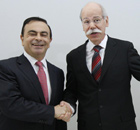Global General
Opposition says it leads Kyrgyzstan after uprising
(Agencies)
Updated: 2010-04-08 10:35
 |
Large Medium Small |
A senior US official, speaking on condition of anonymity due to the uncertainty and delicacy of the situation, said the US was in touch with government officials and the opposition.
"We want to see the situation resolved peacefully, consistent with the rule of law," the official said. "Our conversation with the opposition at this stage is about finding out what is happening and encouraging a peaceful resolution."
The anti-government forces were in disarray until recent widespread anger over the 200 percent increase in electric and heating bills unified them and galvanized support. Many of Wednesday's protesters were men from poor villages, including some who had come to the capital to live and work on construction sites.
Already struggling, they were outraged by the high cost of energy and were easily stirred up by opposition claims of official corruption.
In Washington, State Department spokesman P.J. Crowley said the US deplored the violence and urged all to respect the rule of law.
"We identify with the concerns that the people of Kyrgyzstan have about their future," but those concerns should be dealt with peacefully, Crowley said, adding that the Manas base was operating normally.
Opposition leaders have said they want the base closed because it could put their country at risk if the United States becomes involved in a military conflict with Iran. Closing it would also please Russia, which has opposed the basing of US troops on former Soviet turf.
The United States began using Manas in 2001, two months after the terrorist attacks on New York and Washington, and the base has become essential for transportation, refueling and supply for US-led military operations in Afghanistan.
In 2009, Kyrgyzstan said US forces would have to leave Manas, citing improving security conditions in Afghanistan and dissatisfaction over commercial terms for the base. That eviction announcement came shortly after Russia agreed to grant Kyrgyzstan more than $2 billion in aid and loans, and US officials suggested the eviction decision hinged on Moscow's aid.
The government later reversed its stance and agreed to a revised one-year deal giving US troops rights to use the facility. Under the new lease, the rent increased to $60 million a year, from $17 million.
In addition to the annual rent, the US also will allocate $37 million to build new aircraft parking slots and storage areas, plus $30 million for new navigation systems. Washington has also committed to giving Kyrgyzstan $51.5 million to combat drug trafficking and terrorism and promote economic development.
The unrest began Tuesday in the western city of Talas, where demonstrators stormed a government office and held a governor hostage.
The opposition called nationwide protests for the next day and police in Bishkek at first used rubber bullets, tear gas, water cannons and concussion grenades to try to control crowds of young men in black.
Police often appeared outnumbered and overwhelmed, sometimes retreating when faced with protesters _ including many armed with rocks and others who appeared to be carrying automatic weapons as they marched.
The youths beat up police and seized their arms, trucks and armored personnel carriers.
Some protesters then tried to use an APC to ram the gates of the government headquarters, known as the White House. About a half-dozen young protesters shot automatic weapons into the air from the square in front of the building.
"We don't want this rotten power!" protester Makhsat Talbadyev said, as he and others waved opposition party flags and chanted: "Bakiyev out!"
Some 200 elite police then began firing, pushing the crowd back.
Protesters set fire to the prosecutor general's office and a giant plume of black smoke billowed into the sky.
At one point, police fled across the square from a large group of stone-throwing demonstrators. In another street, some police took refuge behind their shields as one of their colleagues lay unconscious at their feet, his face smeared with blood.
In another area, two policemen, their faces stained with blood, tried to escape as a protester aimed kicks in their direction.
Groups of protesters then set out across Bishkek, attacking more government buildings.
An AP reporter saw dozens of wounded demonstrators lining the corridors of one of Bishkek's main hospitals, a block away from the main square, where doctors were overwhelmed with the flood of patients. Weeping nurses slumped over the dead, doctors shouted at each other and the floors were covered in blood.
Opposition activist Shamil Murat told the AP that Interior Minister Moldomusa Kongatiyev had been beaten to death by a mob in Talas. Later, the Fergana.ru Web site reported that Kongatiyev was badly beaten but had not died, saying its own reporter had witnessed the beating.
Unrest also broke out for a second day in Talas and spread to the southern city of Naryn.
Another 10,000 protesters stormed police headquarters in Talas. The protesters beat up Kongatiyev and forced him to telephone his subordinates in Bishkek and call off the crackdown on protesters, a correspondent for the local affiliate of US-funded Radio Free Europe/Radio Liberty said.
Some 5,000 protesters seized Naryn's regional administration building and installed a new governor, opposition activist Adilet Eshenov said. At least four people were wounded in clashes, including the regional police chief, he said.
In the eastern region of Issyk-Kul, protesters seized the regional administration building and declared they installed their governor, the Ata-Meken opposition party said on its Web site.






